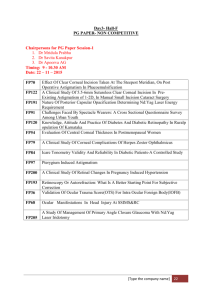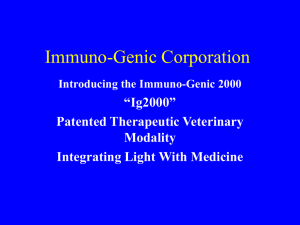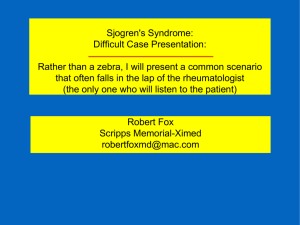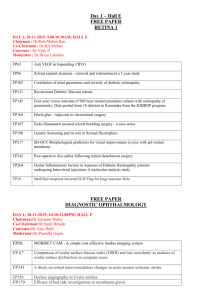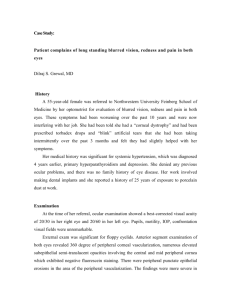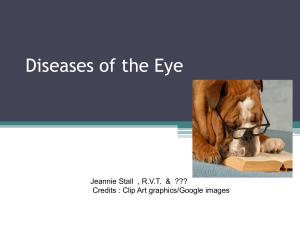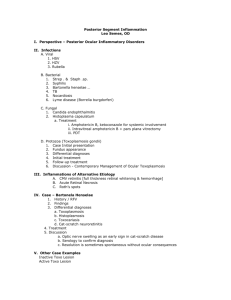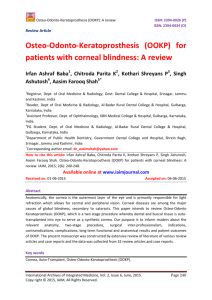Dry eyes resistant to treatment Ophthalmology Times Resident
advertisement
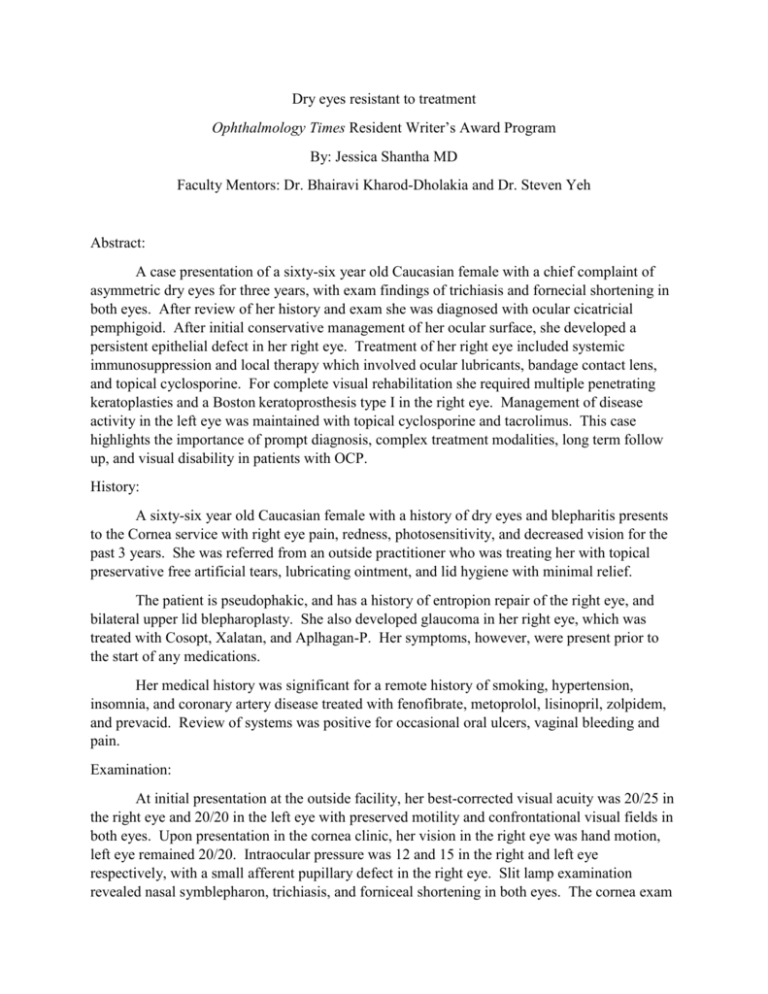
Dry eyes resistant to treatment Ophthalmology Times Resident Writer’s Award Program By: Jessica Shantha MD Faculty Mentors: Dr. Bhairavi Kharod-Dholakia and Dr. Steven Yeh Abstract: A case presentation of a sixty-six year old Caucasian female with a chief complaint of asymmetric dry eyes for three years, with exam findings of trichiasis and fornecial shortening in both eyes. After review of her history and exam she was diagnosed with ocular cicatricial pemphigoid. After initial conservative management of her ocular surface, she developed a persistent epithelial defect in her right eye. Treatment of her right eye included systemic immunosuppression and local therapy which involved ocular lubricants, bandage contact lens, and topical cyclosporine. For complete visual rehabilitation she required multiple penetrating keratoplasties and a Boston keratoprosthesis type I in the right eye. Management of disease activity in the left eye was maintained with topical cyclosporine and tacrolimus. This case highlights the importance of prompt diagnosis, complex treatment modalities, long term follow up, and visual disability in patients with OCP. History: A sixty-six year old Caucasian female with a history of dry eyes and blepharitis presents to the Cornea service with right eye pain, redness, photosensitivity, and decreased vision for the past 3 years. She was referred from an outside practitioner who was treating her with topical preservative free artificial tears, lubricating ointment, and lid hygiene with minimal relief. The patient is pseudophakic, and has a history of entropion repair of the right eye, and bilateral upper lid blepharoplasty. She also developed glaucoma in her right eye, which was treated with Cosopt, Xalatan, and Aplhagan-P. Her symptoms, however, were present prior to the start of any medications. Her medical history was significant for a remote history of smoking, hypertension, insomnia, and coronary artery disease treated with fenofibrate, metoprolol, lisinopril, zolpidem, and prevacid. Review of systems was positive for occasional oral ulcers, vaginal bleeding and pain. Examination: At initial presentation at the outside facility, her best-corrected visual acuity was 20/25 in the right eye and 20/20 in the left eye with preserved motility and confrontational visual fields in both eyes. Upon presentation in the cornea clinic, her vision in the right eye was hand motion, left eye remained 20/20. Intraocular pressure was 12 and 15 in the right and left eye respectively, with a small afferent pupillary defect in the right eye. Slit lamp examination revealed nasal symblepharon, trichiasis, and forniceal shortening in both eyes. The cornea exam of the right eye showed diffuse punctate epitheliopathy, and the left eye was clear. Both eyes had a low Schirmer’s test, no tear lake, and decreased tear break up time. Posterior segment exam was remarkable for an asymmetric cup to disk ratio, but the macula, vessels, and periphery were otherwise normal. Diagnosis, Management, and Clinical Course Initial management included treatment with autologous serum tears in both eyes and a referral to dermatology for additional work up. Detailed history revealed no history of chemical/mechanical trauma, auto-immune diseases, allergies, or use of any other topical ophthalmic medications. Due to a high clinical suspicion for ocular cicatricial pemphigoid (OCP), dermatology performed an oral mucosal biopsy with direct immunofluorescence, which proved to be non-diagnostic. This patient had been treated for many years for chronic dry eyes and blepharitis with worsening symptoms and exam. Initial treatment with lubricating ointment, serum tears, epilation of lashes was insufficient, and she subsequently developed a persistent epithelial defect (6.5X7.9mm), corneal edema, and corneal neovascularization of the right eye with vision of hand motions. Dermatology initiated oral prednisone (20mg) and azathioprine (150 mg) and a bandage contact lens was placed in the right eye. There was minimal response to either treatments, and the patient was started on intravenous immunoglobulin (IVIG) therapy (2gm/kg). A temporary tarsorrhaphy and amniotic membrane graft was performed. The epithelial defect improved with this treatment, but did not completely resolve. The patient’s ocular and systemic symptoms persisted, which led to the discontinuation of azathioprine and addition of Rituximab (700mg) to the IVIG. She developed corneal thinning and a large central descemetocele, which necessitated a therapeutic penetrating keratoplasty (PK). The patient required a total of two PK’s, multiple amniotic membrane grafts, and a scleral contact lens for ocular surface stabilization, and after over a year of treatment, remained at hand motions vision in the right eye. She was continued on topical cyclosporine (0.05%), IVIG treatment at 8 week intervals, and a course of rituximab. Since her systemic and ocular disease appeared quiescent, a Boston keratoprosthesis type I (K-Pro) was placed in the right eye. Three months after the K-Pro, her vision returned to 20/40 with no corneal melt or epithelial defect. Ongoing topical medications have included topical Pred Forte 1% (Allergan, Irvine, CA), gatifloxacin (Zymaxid, Allergan, Irvine, CA), cyclosporine, and tacrolimus ointment (0.03%). Throughout this time the left eye has developed progressive trichiasis with forniceal shortening. She is on topical ocular cyclosporine and tacrolimus for this indication. Discussion: Ocular cicatricial pemphigoid (OCP) is a systemic, autoimmune, sub-epithelial blistering disease that can lead to potential devastating visual outcomes. Its pathogenesis involves a type II immune reaction with immune complex and complement deposition on the epithelial basement membrane. This deposition of immunoreactants leads to inflammatory cell infiltration and recruitment of fibroblasts that lead to permanent scar formation. Diagnosis is by a biopsy of the mucosal surface with direct immunofluorescence (1). The ocular findings in this condition can initially masquerade as common ocular conditions. It usually presents with unilateral conjunctivitis. Foster staging system is used to categorize this disease. Stage one is characterized by chronic conjunctivitis and subepithelial fibrosis. Stage two includes inferior fornix shortening and progression to stage three is symblepharon formation. Stage 4 is considered end stage OCP with corneal neovascularization and surface keratinization (1). The goals of managing this condition include controlling the inflammation and fibrosis to prevent corneal and conjunctival breakdown which leads to corneal scarring and blindness. This is achieved by early treatment of trichiasis and the corneal surface to prevent further progression of epithelial keratopathy, corneal perforation, and bacterial ulcer (1). Local therapies may include moisture chamber goggles, serum tears, topical corticosteroid use, cyclosporine A (Restasis or compounded 2% CSA), tacrolimus, and contact lenses. In retrospective case reviews topical cyclosporine and tacrolimus have been shown in ocular inflammatory disease to be an useful and successful treatment for inflammation (2,3). Trichiasis must also be managed with lash ablation to avoid corneal trauma and recurrent epithelial defects (1). Systemic immunosuppression is required in many of these cases. For mild disease methotrexate, dapsone or sulphapyridine can be used. If there is treatment failure escalation to azathioprine or mycophenolate can be tried. In severe cases, cyclophosphamide is the next line of therapy. Oral or IV steroids should be employed for the first 6-8 weeks with initiation of immunosuppression. Combination therapy, biologics, and IV immunoglobin are treatment options in recalcitrant cases (1,4,5). The surgical care of patients with OCP may include corneal transplantation, amniotic membrane grafts, and in advanced cases the Boston keratoprosthesis procedure. In a recent case series comparing type I and II Boston keratprothesis’s in patients with OCP, vision was maintained at 20/200 or better for one out of six eyes at 3 years (6). Conclusion: This case presentation highlights the complexity in treatment of OCP. Proper care of these patients requires an attentive ophthalmologist and dermatologist for long-term management. The treatment of OCP combines both local and systemic measures with chronic immunosuppression encompassing an array of medications and surgical interventions. Bibliography 1. Saw VP, Dart JK. Ocular mucous membrane pemphigoid: diagnosis and management strategies. Ocul Surf. 2008 Jul;6(3):128-42. Review. PubMed PMID: 18781259. 2. Holland EJ, Olsen TW, Ketcham JM, Florine C, Krachmer JH, Purcell JJ, Lam S,Tessler HH, Sugar J. Topical cyclosporin A in the treatment of anterior segment inflammatory disease. Cornea. 1993 Sep;12(5):413-9. PubMed PMID: 8306663. 3. Lee YJ, Kim SW, Seo KY. Application for tacrolimus ointment in treating refractory inflammatory ocular surface diseases. Am J Ophthalmol. 2013 May;155(5):804-13. doi: 10.1016/j.ajo.2012.12.009. Epub 2013 Feb 6. PubMed PMID: 23394907. 4. Sami N, Letko E, Androudi S, Daoud Y, Foster CS, Ahmed AR. Intravenous immunoglobulin therapy in patients with ocular-cicatricial pemphigoid: along-term follow-up. Ophthalmology. 2004 Jul;111(7):1380-2. PubMed PMID: 15234140. 5. Foster CS, Chang PY, Ahmed AR. Combination of rituximab and intravenous immunoglobulin for recalcitrant ocular cicatricial pemphigoid: a preliminary report. Ophthalmology. 2010 May;117(5):861-9. doi: 10.1016/j.ophtha.2009.09.049. Epub 2010 Jan 4. PubMed PMID: 20045562. 6. Palioura S, Kim B, Dohlman CH, Chodosh J. The Boston keratoprosthesis type I in mucous membrane pemphigoid. Cornea. 2013 Jul;32(7):956-61. doi:10.1097/ICO.0b013e318286fd73. PubMed PMID: 23538625.

